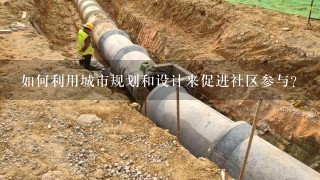如何利用城市规划和设计来促进社区参与?

City Planning and Design for Community Engagement
1. Public Space and Green Infrastructure:
- Create vibrant public spaces with parks, gardens, and green roofs.
- Encourage community gardens and urban farming initiatives.
- Design pedestrian-friendly streets and sidewalks to promote active transportation.
2. Community Centers and Hubs:
- Build community centers that serve as gathering places, cultural hubs, and meeting spaces.
- Design hubs for entrepreneurs, artists, and small businesses to foster innovation and entrepreneurship.
3. Walkable and Bike-Friendly Neighborhoods:
- Create safe and accessible neighborhoods with dedicated bike lanes and pedestrian walkways.
- Encourage mixed-use development to reduce reliance on personal vehicles.
4. Public Transportation and Accessibility:
- Improve public transportation options, including bus stops, light rail, and bike sharing.
- Ensure accessibility for people with disabilities and seniors.
5. Zoning and Land Use Regulations:
- Implement zoning laws that promote mixed-income housing, affordable housing, and community-oriented development.
- Encourage mixed-use development and infill projects to create vibrant neighborhoods.
6. Community Engagement and Planning:
- Establish community boards and participatory planning processes.
- Encourage citizen involvement in decision-making.
- Use technology to facilitate communication and engagement.
7. Art and Culture:
- Incorporate public art, murals, and cultural events into the city's landscape.
- Support local artists and entrepreneurs through grants and initiatives.
8. Social Inclusion and Diversity:
- Create inclusive neighborhoods that welcome people from diverse backgrounds.
- Promote accessibility and affordability for all residents.
9. Economic Development and Job Creation:
- Encourage mixed-use development and job centers to create economic opportunities.
- Support local businesses and entrepreneurs.
10. Sustainability and Environmental Protection:
- Integrate green infrastructure, renewable energy sources, and sustainable transportation options.
- Promote community involvement in environmental cleanup and conservation.
Conclusion:
By implementing these strategies, cities can create vibrant and inclusive communities where residents feel engaged and empowered to participate in shaping their neighborhoods and the city as a whole.





































































